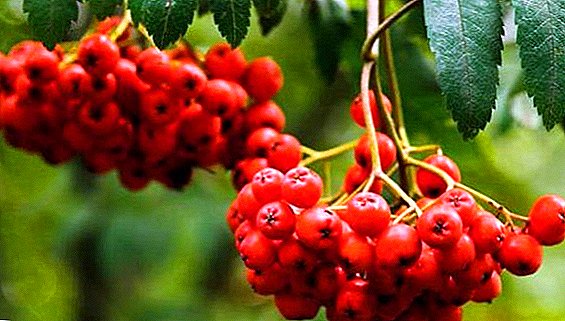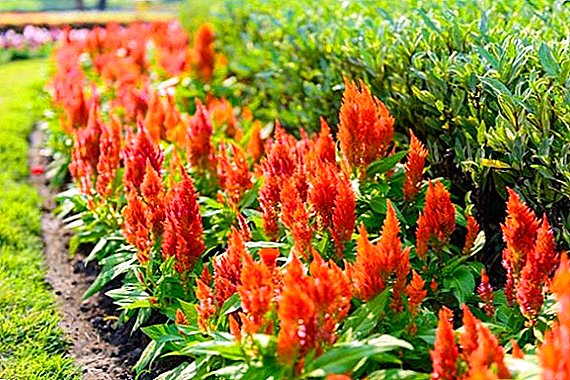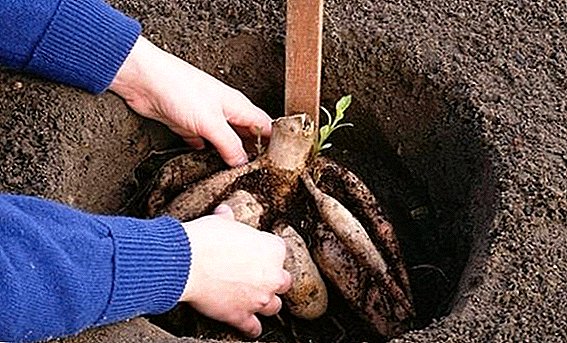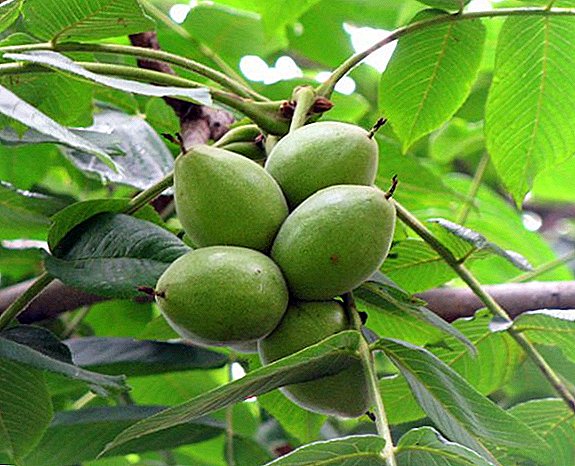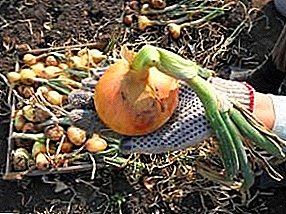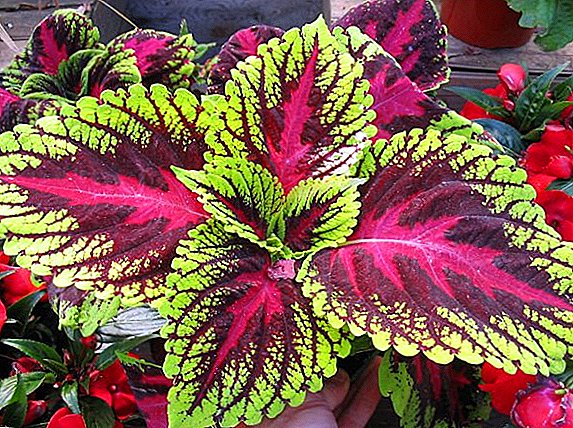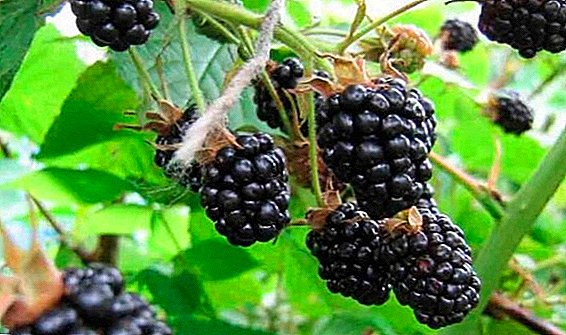 Recently, private gardens have grown popular in home gardens, such as blackberries, although the common habitat of this berry is in the forests. Given that it is unpretentious in care, and all parts of the plant have medicinal properties, it becomes clear why amateur gardeners chose the blackberry. Although this plant is quite thermophilic, it can be cultivated even in the conditions of Siberia. At the same time, it is necessary to choose frost-resistant varieties, properly prepare a place for their planting and ensure proper care for them. This will be discussed below.
Recently, private gardens have grown popular in home gardens, such as blackberries, although the common habitat of this berry is in the forests. Given that it is unpretentious in care, and all parts of the plant have medicinal properties, it becomes clear why amateur gardeners chose the blackberry. Although this plant is quite thermophilic, it can be cultivated even in the conditions of Siberia. At the same time, it is necessary to choose frost-resistant varieties, properly prepare a place for their planting and ensure proper care for them. This will be discussed below.
Cold-resistant blackberry varieties
There are many types of blackberries with high frost resistance, which are acceptable to grow in the harsh Siberian lands.
Among them, the most famous are the following varieties:
- "Black Satin" - one of the most unpretentious berry bushes that can grow everywhere. This variety is strong-growing, sometimes reaches 5-7 meters in height and is completely devoid of thorns. Growing up to one and a half meters, it starts moving along the ground horizontally. Every year on the shrub appears a lot of additional growth, while its root system does not increase. The fruits are ovate-elongated. The average weight of berries - from 4 to 7 grams. They are collected in brushes of 10-15 pieces. After ripening, the fruits have a brilliant black color, they taste sweet, slightly sour. If this variety is provided with proper care and sufficient watering, then during the harvest, up to twenty kilograms of fruit can be harvested from one bush. The time of ripening berries - from late July to late September;
- "Tornfri" - another variety of blackberries without thorns. The plant is quite tall, half-upright, with shoots from 3 to 5 meters and above. Is a high-yielding variety - on each fruit branch from 100 berries and more. The berries themselves are medium in size, about 5-6 grams, oval, have not very saturated black color, with gloss. Fully ripened fruits acquire a sweet taste and noticeable aroma, but become watery. Therefore, berries are harvested a little before full ripening, so to speak, in a state of technical maturity. Fruit ripening begins in early August and lasts for about a month;
- “Abundant” is also a studless culture. It has powerful, long, creeping shoots. This shrub has a vertical root system, so when growing bushes can be located at a short distance from each other (from 2 to 2.5 m). The berries are large, oblong, weighing up to 7 grams and above, have a pleasant taste. At first, the ripening is dark red, and fully ripened berries are black;
- Agave is a spiky blackberry. Bushes grow powerful and tall, up to three meters. The variety is considered particularly winter-hardy: it can withstand up to -40 degrees. Up to 4 kilograms of berries are harvested from one bush. The weight of each blackberry is up to 3 grams. Abundant fructification - up to 20 berries per hand. Berries are sweet, shiny, black, cone-shaped. The variety is mid-season, ripens by the end of August;
- "Darrow" - a variety of upright lash length up to 3 meters. This shrub is also frost-resistant, can withstand cold to -35 degrees. It is considered high-yielding - up to 10 kilograms from a bush. Berries are large - up to 4 grams, the taste is sweet-sour, oblong, glossy-black. Fruits ripen for one and a half months, re-fruiting is possible.




Read also about the varieties of blackberry: new, beshipny, remontant; “Giant”, “Ruben”, “Chester Thornless”.
When to plant
The best time to plant blackberries in such climatic conditions of Siberia is spring period. Thanks to the landing in the spring, shrubs will be able to root well and get stronger during summer time before long winter. Also, spring planting will protect the culture from freezing.
Where to plant on the site
For planting blackberries need to choose protected from drafts and strong winds placesFor example, along fences and fences. Also for good growth of culture and ripening of fruits there should be enough sunlight. Choosing a suitable place for planting shrubs, you need to remember some plant features:
- due to the fact that the blackberry is growing rapidly, it should be planted at a distance of 2 meters between the bushes for ease of harvesting. To the fence should also be a distance of half a meter;
- due to lack of solar lighting, shoots can be drawn out and not mature well. This can lead to less yield in the summer and lower the shrub’s resistance to cold weather;
- Blackberries do not like wet soils, so it should not be placed in lowlands where snow or water accumulates after precipitation. Groundwater at the site where the blackberry is planted should be at a depth of more than 1 meter;
- the culture is demanding to the ground: if there is not enough magnesium and iron, then it will have a bad effect on the development of the shrub.
 At the place chosen for planting, precursors can be planted in advance: leguminous crops.
At the place chosen for planting, precursors can be planted in advance: leguminous crops.
For leguminous crops include beans, beans, peas, lupins, vetch.
Pre-work
To plant blackberry bushes was successful, it is necessary to carry out some preliminary work.
Did you know? The Russian name shrub got because of its spines. Blackberries - that is, prickly, like a hedgehog.
Site preparation
The first step is to clear the selected area from debris, weeds and various rhizomes. Then carefully dig up the soil, the depth of the spade on the bayonet. Before this, a mixture of organic and mineral substances in this composition must be introduced into the soil: 10 kilograms of humus mixed with 20 grams of potassium sulphate, 200 grams of ash and 15 grams of superphosphate.
If in the soil high acidity, it still brings lime. All this is evenly distributed over the surface of the site before digging. All these actions need to be done a month before planting the crop.
Learn more about soil acidity: the significance of soil acidity for plants, self-determination of soil acidity, soil deoxidation.
If the soil is in your area with a high level of humidity, then you need to plant it on the beds, and if it is dry, the bushes are planted in a rut, not completely covered with earth. 
Seedlings preparation
Before you start planting shrubs, cuttings must be carefully examined. It is very important that the root system of the planting material is sufficiently moist, has a brown color characteristic of healthy cuttings, and the presence of mold is also unacceptable. If planting material does not have to be planted immediately after it has been received, it should be stored with moistened roots in a cool room, not in direct sunlight. Before direct planting, it is recommended to soak the roots for several hours in water or a root formation stimulator.
If you have to transport seedlings, you can wrap them with a damp cloth or wet sawdust, and then with a film. So the roots will not dry out for a long time.
Read also about the beneficial properties of blackberry, as well as the differences between black raspberries and blackberries.
Definitely it is impossible to plant cuttings when there is still a threat of freezing of the root system due to possible frosts. Therefore, it is necessary to monitor weather forecasts. 
How to plant blackberry seedlings
So, go to disembarking:
- Place the blackberry on a wire trellis in one or two rows. On either side of the trellis, pits are prepared for planting 40 by 40 centimeters in size, at least 50 centimeters deep. These are optimal sizes for qualitative development and root growth, which are different in blackberry power. The pits must be located at a distance of at least 1 meter from the border with the area of neighbors, if the rows are parallel to it. Small rows, one and a half to two meters long, can be placed perpendicular to the fence, preferably on the south side of the site. Between rows, a space of up to 2.5 meters is left, and the bushes themselves in a row are placed at a distance of 1 meter to 1.5. If blackberries are planted with bushes, then the landing pattern looks like this: 1.8 by 1.8 m.
- Next, humus is poured at the bottom of each pit and mixed with the ground. It is imperative to pour a layer of soil on top of this mixture so that the delicate roots of the cuttings cannot come into contact with the humus itself.
- Then, carefully place the cutting on the bottom of the fossa, gently sprinkle the roots with earth and compact it. So you need to pour a few layers, strictly making sure that the seedlings are planted to the depth of the root collar.
- Considering that the blackberry likes water very much, it is necessary to water the seedlings quite well while planting it, but not excessively. About 5 liters of water are used for each bush. This should be done while pouring each individual layer of soil: water and let each portion of water be well absorbed, and then pour the next layer of earth.
- At the end of the planting, seedlings need to be cut from the above-ground part with the help of a secateur, while leaving 2-3 buds on the trunk. Such pruning will stimulate the growth of “sleeping” buds on the root system. It is from them that the plant will develop young shoots.
 It should be taken into account that during watering the soil with seedlings sags, therefore plants should be planted at the optimum depth: not higher and not lower than the level of the root collar. If you do not take these recommendations into account, then the roots that are planted high may freeze roots, and those that are planted low may slow the growth of the shoots or the plant will not develop at all and will die.
It should be taken into account that during watering the soil with seedlings sags, therefore plants should be planted at the optimum depth: not higher and not lower than the level of the root collar. If you do not take these recommendations into account, then the roots that are planted high may freeze roots, and those that are planted low may slow the growth of the shoots or the plant will not develop at all and will die.
Did you know? Blackberry has long been considered a medicine, for example, in the writings of Paracelsus there is a recipe for medicinal decoction based on its berries and leaves.
Aftercare
After planting blackberries, she needs to provide the right care, which is watering, feeding, pruning and sheltering plants from frost. Next, consider in detail the features of such works.
Watering
Blackberries are watered for one and a half months, and especially - during the growing season in hot weather. During the first year, the planted plants are watered regularly, and between irrigations they loosen the soil between the rows (at a depth of 10 cm), destroying the weeds so that they do not take the nutrients needed by the growing and emerging bush.  Loosening between the bushes is also necessary, but at a shallower depth (5-8 cm) in order not to damage the roots of the plant. It is necessary to loosen, both for better air exchange and weed destruction, and because in this way it is possible to destroy the places of wintering of harmful insects.
Loosening between the bushes is also necessary, but at a shallower depth (5-8 cm) in order not to damage the roots of the plant. It is necessary to loosen, both for better air exchange and weed destruction, and because in this way it is possible to destroy the places of wintering of harmful insects.
Important! You can not use cold water to irrigate young blackberry plantations.
Top dressing
To increase the yield of blackberries need a good and systematic feeding or mulching plantings. Due to the fact that the roots of shrubs lie shallow, the dressing should be done very carefully, especially since buds of future spring shoots are formed on the roots close to the surface.
In order to mulch it is best to use rotted manure, peat compost, straw, sawdust, leaves and any other loose organic matter.
If you mulch the plant with manure (4-5 kg per 1 square meter), the soil will be sufficiently hydrated and enriched with nutrients. This, in turn, will contribute to the formation of strong and branched roots.
Manure of various animals (pig, sheep, cow, rabbit, horse) differs in composition and properties.
Feed the blackberry is better before the formation of offspring. In addition to feeding for garden crops, the use of mulch has other important functions - it can suppress the growth of weeds and slightly speed up the ripening of the berries. If the soil is damp, then it is not recommended to mulch it.  If it is nitrogen fertilizer, then they are applied moderately, otherwise they may delay the growth of the shoots of the shrub and contribute to its susceptibility to cold weather. Potassium fertilizers are applied every year (40 g). Chlorine-containing feedings are contraindicated. If manure is applied annually, then phosphate fertilizers should not be used, if organic fertilizers are absent, then after three years phosphate fertilizers should be applied (at the rate of 30 grams per 1 square meter).
If it is nitrogen fertilizer, then they are applied moderately, otherwise they may delay the growth of the shoots of the shrub and contribute to its susceptibility to cold weather. Potassium fertilizers are applied every year (40 g). Chlorine-containing feedings are contraindicated. If manure is applied annually, then phosphate fertilizers should not be used, if organic fertilizers are absent, then after three years phosphate fertilizers should be applied (at the rate of 30 grams per 1 square meter).
Did you know? In antiquity, blackberry leaves and berries collected before the end of September were used in spells for wealth and beauty.
Garter on the trellis
Blackberries need its shoots to be tied up for trellis stability. To do this, fruit sticks are tilted in one direction and tied to the rows of wire at a height of 90 centimeters and one and a half meters. Young branches are sent to the other side and tie up the same way. You can do it differently: the fruit branches are tied up from two sides, and the young - to the uppermost line of the wire. The garter serves as a twine.
Find out what you need and how to make a trellis with your own hands.

Pruning
In the spring of blackberry shoots need to cut 10 centimeters. This will contribute to a good harvest. Pruning is done several times: in the spring, the tops of the overwintered lashes are cut off, and in the fall - those that have already been harvested, or infected with fungus, or pests. You can also remove the excess young shoots.
Important! Last year's scourge need to be cut at the root, otherwise pests will settle in the stumps, which will be able to safely winter.
To increase the yield of blackberries, it is necessary to make a nip from the growing lashes of replacement twice a year. The first time it is done at the end of May, the second - at the end of July. Shoots should be up to 90 centimeters in length. Pinching will give additional branching and growth of lashes in thickness, and, consequently, an increase in the bookmark of flower buds will occur.
In the autumn it is also recommended to prune all old, weak and excessively stretched branches.
Read also about the features of growing plants in Siberia: lavender, perennial flowers, cherries, grapes, hydrangeas, juniper, thuja, rhododendron, beets, onions.

Shelter
After liberation of blackberry bushes from excess shoots in the autumn, you can begin to cover them for the winter. Even if your blackberry is cold-resistant, it still needs shelter.
The first thing you need to tie the whip several in a bunch and bend down to the ground, securing them with hooks. Such manipulations can be done with creeping varieties. If you have a blackberry upright, and not weaving, then you need a different approach: even in the summer, small weights can be tied to the tops of the lashes. Under their weight, the whips themselves will gradually bend down to the ground. After the leaves are discharged, the shrubs need to be bent stronger, and then covered for wintering.
For shelter, sawdust, hay, straw, tops of garden crops are used. You can also take a ruberoid. Another version of the blackberry shelter for the winter: put the boards on the ground, lay shoots on them and fix them. After that, spray them with a solution of blue vitriol and cover with hay, spruce branches.
Important! The leaves of fruit trees cannot be used as a covering material, since they can serve as a wintering medium for pest larvae.
Video: Blackberry growing experience in Siberia
Blackberries in Siberia: reviews gardeners


As you can see, the cultivation of blackberries in the harsh conditions of Siberia does not present any particular difficulties. Если вы обеспечите этой культуре на своём участке все подходящие условия, то поможете ей успешно перезимовать, а в следующем сезоне порадовать вас обильным урожаем вкусной и полезной ягоды.


